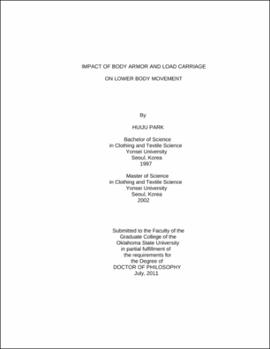| dc.contributor.advisor | Branson, Donna | |
| dc.contributor.author | Park, Huiju | |
| dc.date.accessioned | 2013-11-26T08:23:23Z | |
| dc.date.available | 2013-11-26T08:23:23Z | |
| dc.date.issued | 2011-07 | |
| dc.identifier.uri | https://hdl.handle.net/11244/6705 | |
| dc.description.abstract | Scope and Method of Study: The overall purpose of this study is to compare impacts that personal body armor and carrying loads have on lower body movement by using motion capture, Electromyography (EMG) and foot pressure technologies. Seven healthy male ROTC students participated in a human subject test. The independent variable was garment condition with seven levels. Seven treatment garments included 4 levels of weight (1/8 lb, 20 lb, 40 lb and 60 lb) with varying weight distribution. Treatment 1 was a 1/8 lb pair of snuggly fitting sports shorts. Treatment 2 (T2) was a 20 lb Outer Tactical Vest (OTV) in addition to wearing T1. Treatments 3, 4 and 5 (T3, 4 and 5) included wearing T2 and a 20 lb carrying load attached to three different OTV locations. Treatments 6 and 7 (T6 and T7) included wearing T2 and a 40 lb carrying load attached to the OTV in two different locations. Temporal and distance parameters of walking patterns, Range Of Motion (ROM)s, maximum joint angle (joint anglemax), peak EMG amplitude on four leg muscles, plantar pressure and contact area of the foot were measured as dependent variables while subjects walked barefoot wearing seven different garments. In addition, subjects' perceptions about ease of walking were also assessed by using a ballot with a 5-point Likert scale. Gait analysis and statistical analyses were used to identify changes in lower body movement while walking under the seven garment treatment conditions. | |
| dc.description.abstract | Findings and Conclusions: Significant garment effects were found for four temporal and distance parameters of walking (stance phase, swing phase, double support and stride length); six ROMs (pelvic obliquity, hip adduction-abduction, pelvic tilt, hip flexion-extension, pelvic rotation and hip rotation); two joint anglemax (pelvic intrarotation and pelvic extrarotation); peak EMG amplitude on the rectus femoris; and peak plantar pressure at the forefoot and rearfoot, average plantar pressure and change in contact area. Subjects reported perceiving increased limitation in lower body movement, discomfort and fatigue, as weight of garment and carrying load increased. | |
| dc.format | application/pdf | |
| dc.language | en_US | |
| dc.rights | Copyright is held by the author who has granted the Oklahoma State University Library the non-exclusive right to share this material in its institutional repository. Contact Digital Library Services at lib-dls@okstate.edu or 405-744-9161 for the permission policy on the use, reproduction or distribution of this material. | |
| dc.title | Impact of body armor and load carriage on lower body movement | |
| dc.contributor.committeeMember | Peksoz, Semra | |
| dc.contributor.committeeMember | Petrova, Adriana | |
| dc.contributor.committeeMember | Jacobson, Bert | |
| dc.contributor.committeeMember | Warren, Aric Jon | |
| dc.contributor.committeeMember | Goad, Carla Lynn | |
| osu.filename | Park_okstate_0664D_11546.pdf | |
| osu.accesstype | Open Access | |
| dc.type.genre | Dissertation | |
| dc.type.material | Text | |
| dc.subject.keywords | body armor | |
| dc.subject.keywords | emg | |
| dc.subject.keywords | gait | |
| dc.subject.keywords | load carriage | |
| dc.subject.keywords | mobility | |
| dc.subject.keywords | range of motion | |
| thesis.degree.discipline | Design, Housing and Merchandising | |
| thesis.degree.grantor | Oklahoma State University | |
